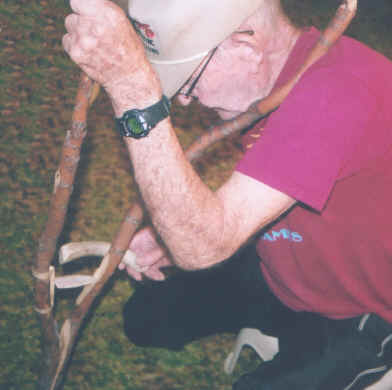|
"An invention is something new and useful.
The word applies to the apparatus of human activities and to the
processes involved."---1912,
Fredrick Webb Hodge, Handbook of American Indians North of Mexico, Part
1.
"One might
achieve a flute-like flake by accident, but only by carefully crafting a
process can such flakes be made routinely"---2005,
Bob Patten, Peoples of the Flute, A Study in Anthropolithic Forensics,
p.137.

JOHN ALEXANDER'S
FORKED LIMB FLUTING
John Alexander, everyone calls him "Swoose," has been flintknapping, off and on,
for many decades and he's experimented with several different flake
removal techniques. But his fluting process with the use of a forked
limb and antler billet has caused the most interest. He has
demonstrated this technique at two or three knap-ins over the last
couple of years. This technique was first described in Bob Patten's book
"Peoples of the Flute, A Study in Anthropolithic Forensics,"
(2005, pp. 245-246). Bob uses the term "axial compression" to
describe "Swooses's" method of fluting.
|
|

JOHN ALEXANDER
("SWOOSE")
FLUTING A POINT
This picture shows "Swoose" in the process of fluting a
point using his forked limb
lever method. The wood he is using is
mesquite
but other types of wood should also work. On one end of the fork he
has lashed a piece of deer antler which presses against the platform on the
base of the preform. The antler also has some shallow grooves cut
into the surface to help hold the preform steady. The other end of the point is pressing against
the wood. "Swoose" says he estimates between 200 and 300
pounds of pressure is needed
before he lightly tapes the flat side of the point near the platform
to detach the flake. The flake usually flies away leaving the
preform still in position. Covering the preform with a small piece
of cloth or clear plastic before striking will prevent the flakes
from becoming air born. "Swoose" has fluted seven and
eight preforms in a row without any difficulty. |
|
|
"Swoose" lives in a small west Texas town
called McCamey where he's called home for 86 years. He has many other
talents other than flintknapping. The local community is proud of his
athletic accomplishments. In various Senior Texas and World track and
field events he's held 9 age group world records and received over 400
gold medals. In 2000 John Alexander was inducted into the Texas Senior
Games Hall of Fame.
|
|

CLICK ON
PICTURE FOR LARGE IMAGE
FLUTED PREFORMS
FLUTED WITH FORKED LIMB
BY
"SWOOSE"
These four preforms were fluted using "Swoose's" forked
limb
method. The preforms were made by the flake-over-grinding
technique and no attempt was made to flute the other sides. These
were made only to demonstrate the forked
limb
fluting device. Remnant
platforms can be seem on the bases. The longest example on the right
measures 3 1/4 inches (8.2 cm) long. |
|
|
When asked how he came up with the idea of fluting in
this peculiar way, "Swoose" says he was exposed to the basic
concept when he was stationed in New Guinea during World War II. New
Guinea was and still is one of the best locations in the world to
observe primitive technology. He was
assigned to the 912 signal company and was on active duty from
1942-1945. Before
the war, "Swoose" was a ham radio operator. He began with his
crystal set in 1933. His knowledge of
electronics guided his time in the military towards radar, specializing
in repair and installation. In New Guinea he says when the local natives
needed power to do something, they used levers. His experimenting with
pressure using a lever has produced a simple forked limb method of
removing a long Cumberland style channel flake.
|
|

FLUTED PREFORM
FLUTED BY LEVERING
A HOE HANDLE AGAINST A TREE TRUNK
BY JOHN ALEXANDER
("SWOOSE")
The long channel flake on this preform was removed by
applying pressure against the platform with a garden hoe handle on
one end and the point against a small tree trunk at the other end.
The lower end of the hoe handle was on the ground. A
slight percussion strike near the platform initiated the release of
the flake. Flintknapper and primitive technology instructor Bob
Withrow suggested that this same procedure could have been
accomplished with the use of a spear shaft pressing against a
tree or piece of wood. In-other-words the primitive tool kit needed
to make Barnes or Cumberland flutes using pressure may not have
needed any additional tools other than what was already at hand. |
|
|
Swoose says there are not very many trees in
west Texas around McCamey, so he's had trouble finding usable tree
limbs. The forked and crooked limb illustrated in this article was taken
from a mesquite tree or shrub. He says it's not fancy but it has
successfully fluted many points.
|
|
CONTINUE ON TO PAGE
TWO
|
|
"REFERENCES"
1912,
Hodge, Fredrick Webb, "Handbook of American Indians North of Mexico,"
Part 1, pp. 611-612.
2005, Patten, Bob, "Peoples of the Flute, A Study in
Anthropolithic Forensics," pp. 137, 245-246.
Personal communications with John Alexander "Swoose,"
(flintknapper).
Personal communications with Bob Patten, (flintknapper & author).
Personal communications with Mike Dothager, (flintknapper).
Personal communications with Bob Withrow, (flintknapper & primitive
technology instructor).
|
|
RECENT
LISTINGS HOME
ORDERING |




